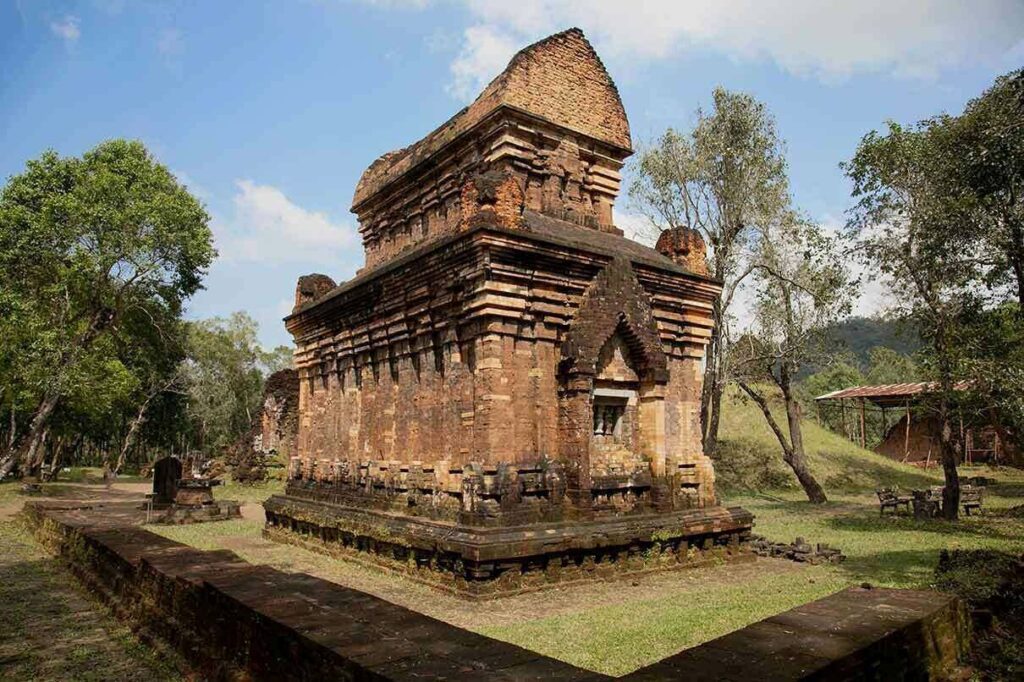
My Son Sanctuary: A Sacred Cham Relic Over 1600 Years Old
Updated: March 2023.
Located west of Hoi An, Vietnam is My Son Sanctuary, Quang Nam, a culturally and historically important site that boasts expansive Hindu temple remains from the Champa people. While not as grand in scale as the likes of Angkor Wat in Cambodia, My Son is a hugely important monument to history and an exceptionally well-preserved example of Cham/Hindu architecture.
These Cham temples, stone pillars and towers are astonishingly well-preserved and a must-visit during your stay in Hoi An. The journey to and from Hoi An Ancient Town is an easy half-day trip.
You’ll find everything you need to make the most of your visit to My Son below.

- My Son Sanctuary: A Sacred Cham Relic Over 1600 Years Old
- My Son Sanctuary: UNESCO World Heritage Site
- What is My Son Sanctuary?
- Ancient Cham Building Techniques at My Son Sanctuary
- Where is My Son Sanctuary?
- History of My Son Sanctuary in Hoi An
- My Son Museum
- My Son Sanctuary Operating Hours
- Getting from Hoi An to My Son Sanctuary
- What to wear at My Son
- Best Time Of Day To Visit
- Aspara Dance, Folk Dance & Music
- Points of Interest
- Frequently Asked Questions
My Son Sanctuary: UNESCO World Heritage Site
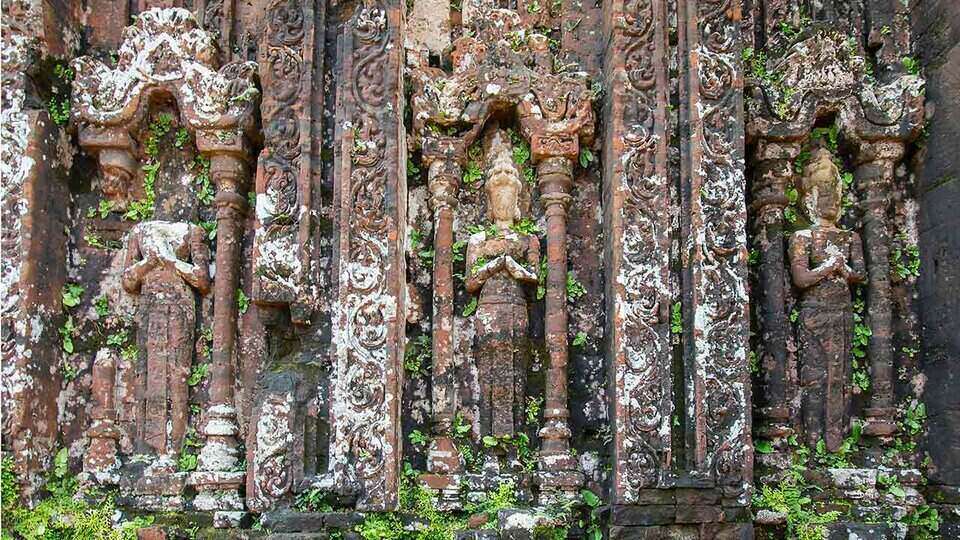
My Son Sanctuary is one of the most important archaeological sites in South-East Asia and a major tourist destination. In 1999, My Son Sanctuary Vietnam was named a UNESCO protected World Heritage Site for its unique blend of Hindu culture, architecture and natural beauty. My Son Sanctuary is considered to be an irreplaceable source of ancient Cham art and culture, providing invaluable insight into how this civilization lived and worshipped hundreds of years ago.
My Son was an important center of Hindu worship for the Cham people who were devotees of Shiva, the Hindu god of destruction and creation. Filled with stunning temples dedicated to Lord Vishnu and Shiva that are decorated with intricate carvings depicting scenes from Hindu mythology, My Son Sanctuary provides visitors with an up-close look at the religion, art and culture of the Cham people.
My Son features numerous sculptures of Lord Shiva, large elephant sculptures, lotus-shaped stupas, sacrificial altars, linga sculptures (representing Lord Shiva), yoni sculptures (representing female energy) and other unique motifs. Some of these are carved directly into the walls of its impressive tower temples. It is a living testament to the grandeur of ancient Indian architecture that spread around South East Asia during this period in history.
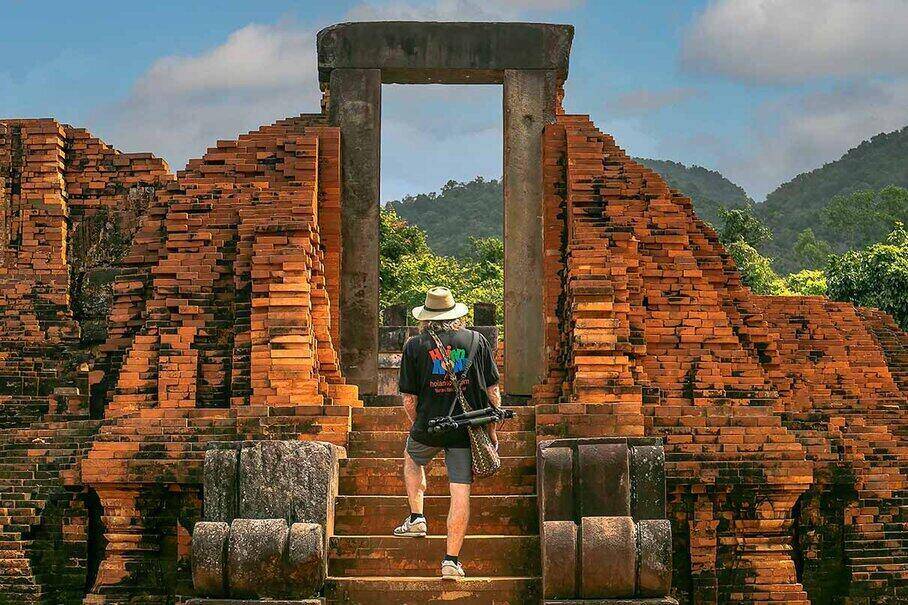

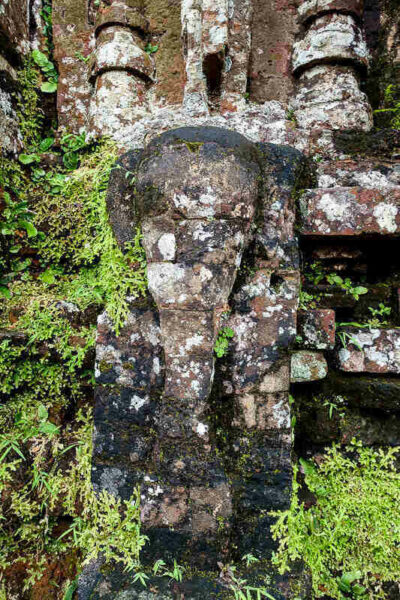
What is My Son Sanctuary?

Whether you are a history buff or not, My Son Sanctuary’s temple complex in central Vietnam will mystify and enchant your senses. It offers a unique glimpse into Cham culture and Vietnam’s history. When you walk through the site used by previous kings and religious leaders from centuries’ past, you’ll be drawn back to another time.
My Son was not just a place to construct temples, perform rituals and worship. It was also where victories and conquests were commemorated.
From the 4th to the 14th century CE, the narrow, V-shaped valley at My Son Sanctuary was a site of religious ceremony for kings of the ruling dynasties of Champa, as well as a burial place for Cham royalty and national heroes.
It was closely associated with the Champa religious and political capital between the 4th and the 8th centuries, Simhapura (Tra Kieu) and another nearby Cham city, Indrapura (Dong Duong) that was the Champa capital for a couple of hundred years after that (though there are many competing theories about the actual time lines).
My Son Sanctuary is an impressive complex of Hindu temples, ruins and sculptures built by the Champa civilization. The temples are dedicated to the worship of the god Shiva in the main. Shiva was known under various local names, the most important of which is Bhadreshvara.
Ancient Cham Building Techniques at My Son Sanctuary
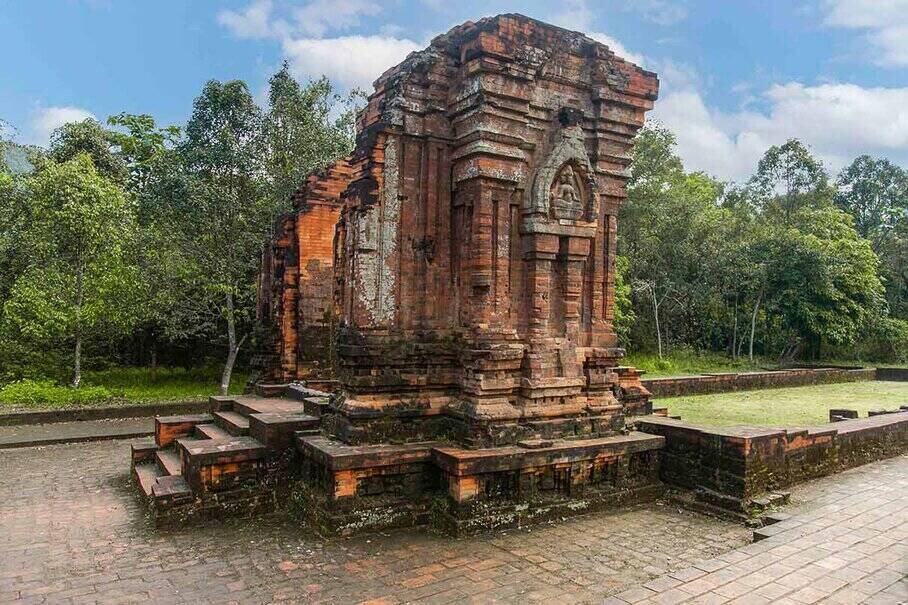
The Ancient Road
If you take the left path into My Son Sanctuary the first thing you come across is a gate tower. And leading from that tower is an ancient road, 8 meters wide with 2 parallel walls and an excavated surface 1 meter below ground level. According to some sources the tower was reserved for sacrifices and rituals for kings and nobility – others could not enter. The road once led several hundred meters further on to the heart of the sanctuary.
The Building Materials and Techniques
To this day, the construction techniques used by the Cham builders are not completely understood. Unresolved issues include competing theories about the firing of the bricks, the mortar between the bricks, and decorative carvings found on the bricks.
Most agree the bricks were hardened by fire, but was it before or after construction? Similarly, were the elaborate carvings on the external walls done before or after construction? And how were the bricks stuck together? No one knows. Was it a lost technology using tree resin?
Where is My Son Sanctuary?
The My Son ruins are located in central Vietnam in Quang Nam province. My Son Sanctuary is in a small, narrow valley the nestles between mountain ranges of tropical jungle. It’s situated in Duy Tan Commune, Duy Xuyen District of Quang Nam Province or about 43 km west of Hoi An and 70 km southwest of Da Nang.
When the Cham people ruled the area, the Champa historic capital of Tra Kieu (Simhapura) was just 10 kilometers away, enabling easy access to this spiritual hub.
History of My Son Sanctuary in Hoi An
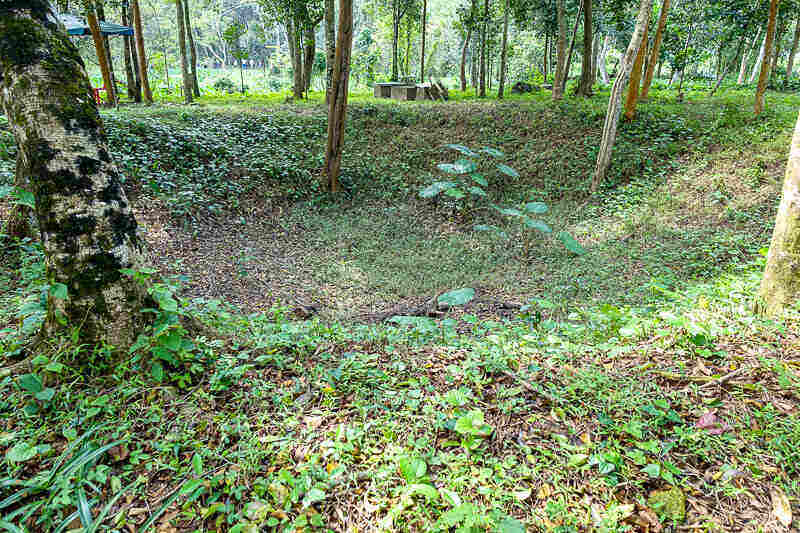
During the years of the Champa Kingdom, the main spiritual affiliation was Indian Hinduism for Cham royalty and the general community. For this reason, many of the temples were built and devoted to Hindu divinities such as Krishna, Vishnu and Shiva. Shiva was the most represented as this deity was considered a protector.
Over the years, My Son was ruined and rebuilt, destroyed numerous times by fire and war and then eventually forgotten about for centuries until it was rediscovered by the French in 1898.
Unfortunately, the American-Vietnamese War was responsible for some of the most destructive damage to the site. The inaccessibility of the region made it a great hiding place for North Vietnamese forces and liberation fighters. The US Air Force bombed the area but, unfortunately for posterity, My Son suffered while the hidden military base remained intact. Luckily, 17 out of 71 structures survived and parts of the ruins have been rebuilt and conserved since 1975.
My Son Museum
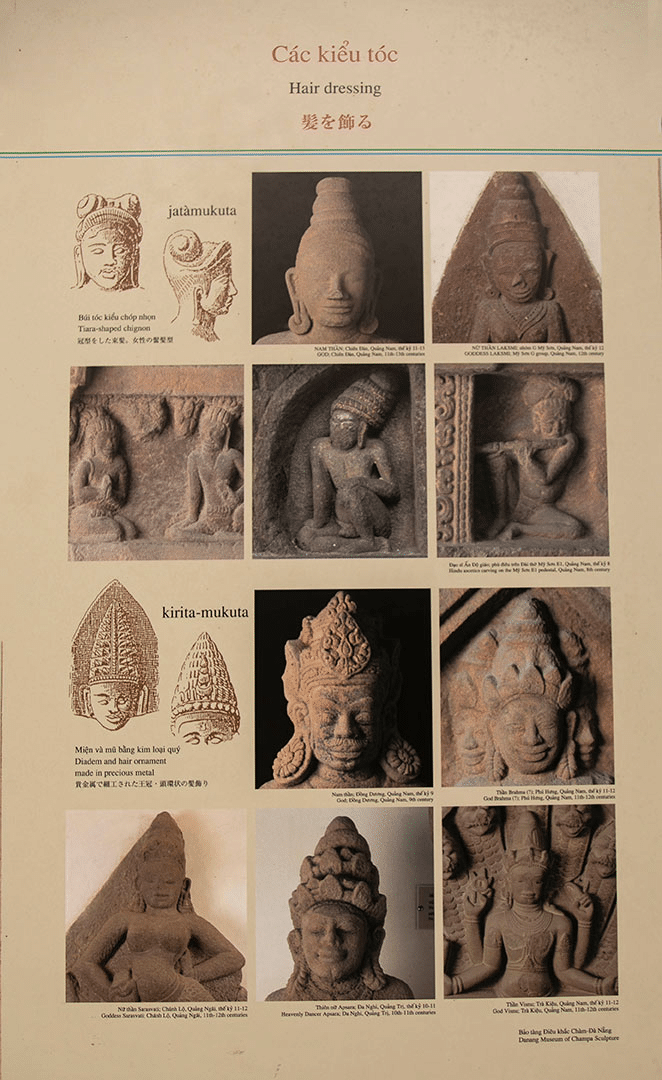
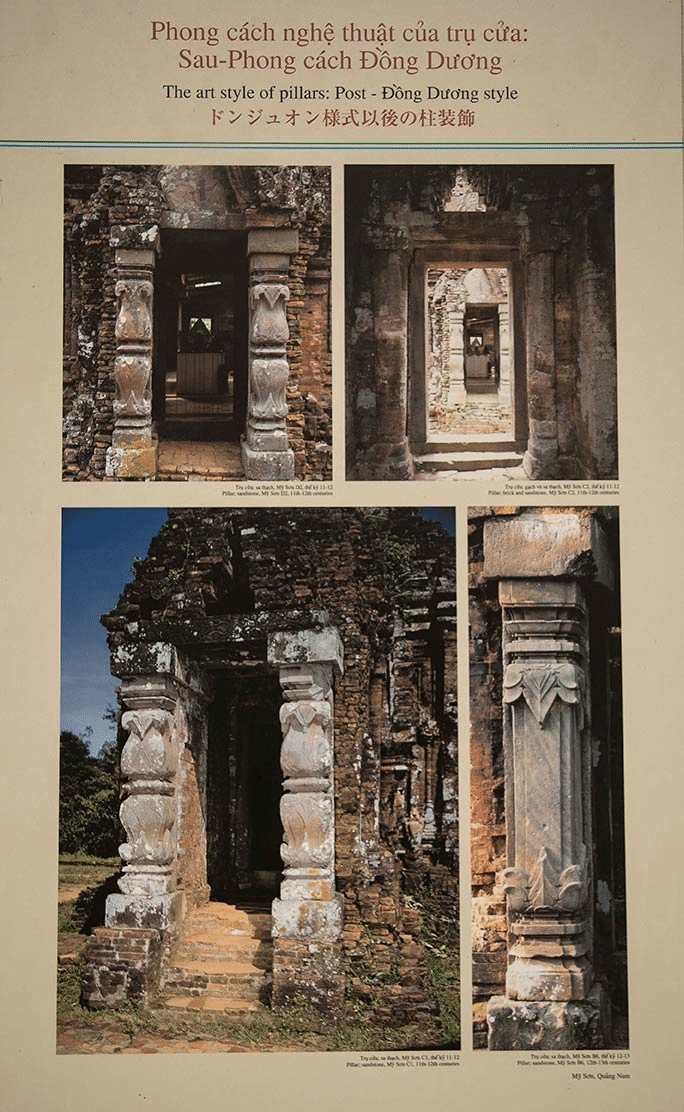
If you’re interested in learning more about the temples before you explore the ruins, there is free access to a museum on site. The museum provides more detailed information on the historical, religious and archaeological significance of My Son Sanctuary. We recommend engaging a guide (100,000 VND / 4.60 USD), but whether you do or don’t, a visit to the museum is highly recommended before you venture further.
My Son Sanctuary Operating Hours
My Son Sanctuary is open between 6am and 5pm Monday to Sunday.
Getting from Hoi An to My Son Sanctuary
My Son Sanctuary is approximately 43 km west or a 1 hour and 15 minute drive from Hoi An. Following is detail on the best ways to get to My Son and access details.
My Son Sanctuary Tour
Experiencing My Son Sanctuary through a tour is a great option if you want to do less work planning your own logistics. A tour makes it easy by either picking you up from your hotel or from an easy to find, central meeting place.
Booking a tour is a popular option as it includes round-trip transport from Hoi An as well and an informative tour guide. However, you will be more restricted to a schedule and may find yourself part of a large group which can have a downside.
If you prefer a more leisurely, comfortable but more expensive option, it’s also possible to book a private tour.
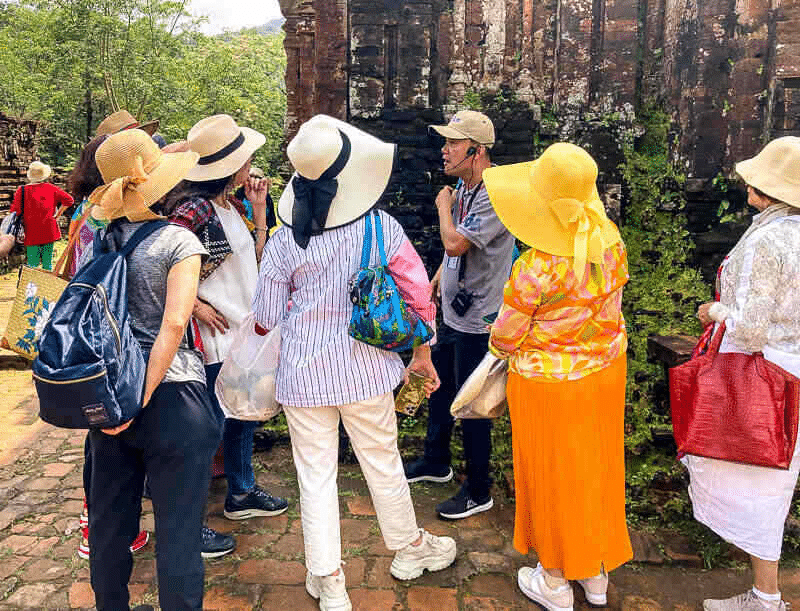
Hiring a Private Car To Visit My Son
You can book a tour as mentioned above or simply hire a car that picks you up from your accommodation in Hoi An and go privately. The driver will wait as part of the package.
The cost of a private car including waiting time is around 25-30 USD and a guide can be picked up near the electric shuttle drop-off for 100,000 VND if you want one (recommended).
To My Son by Motorbike
If you already have a motorbike, this will be your cheapest option.
Note: We recommend driving yourself only if you have prior experience with a motorbike. If you don’t have much experience you can always hire an EasyRider or Grab to drive the bike for you. And be aware of the rules and regulations surrounding a Vietnam motorbike license before you travel.
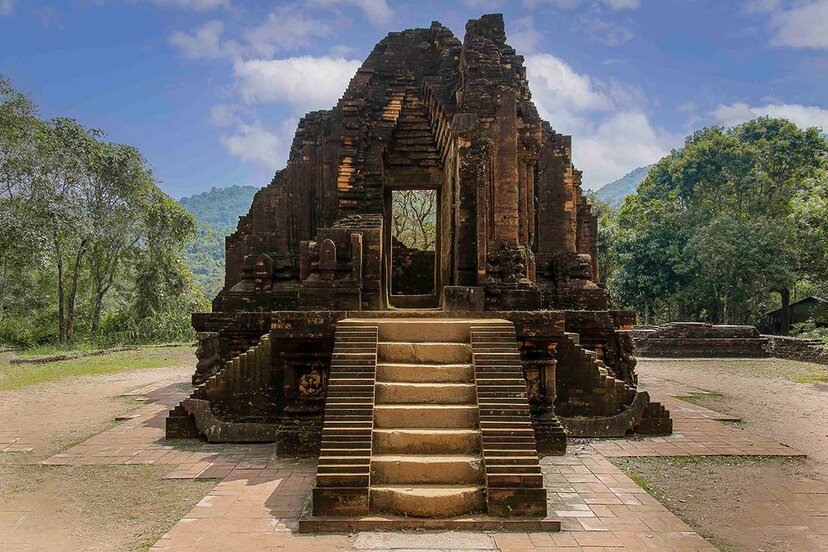
My Son Sanctuary Entrance Fee
If you are on a tour the entrance fee is already costed in. If you roll up by yourself the fee is 150,000 VND per person. This includes 2-way transfers by electric shuttle bus and entry to the Aspara dance and folk music performed by Cham people.
Get a Guide at My Son
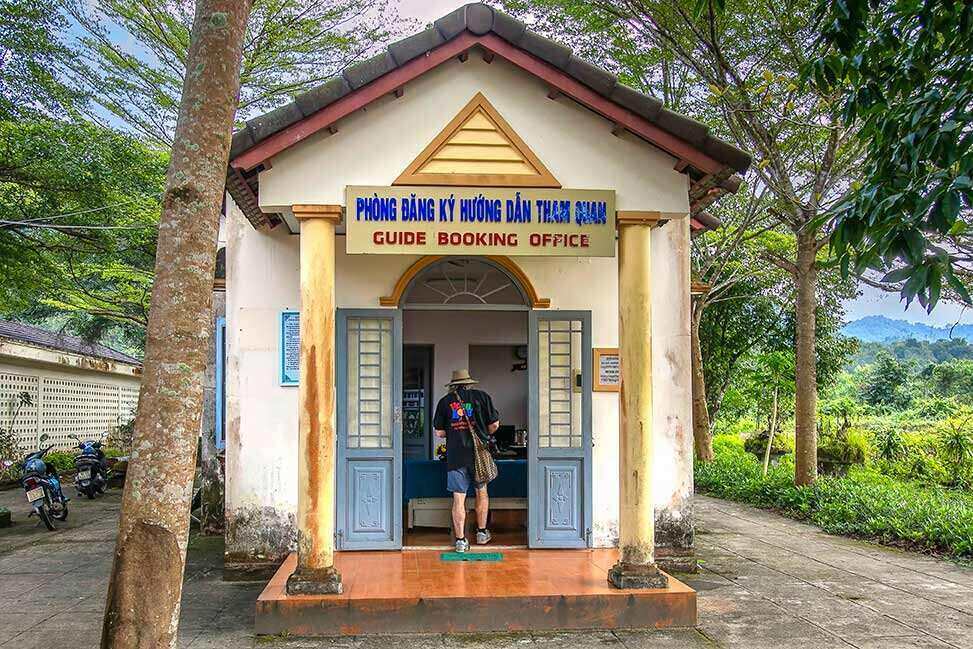
As mentioned above, if you choose to take on My Son by yourself, hiring a private car to get there is the recommended option. Also, if you’re interested in the cultural and historical significance of the site, get yourself a guide as its inexpensive at around 100,000 VND and really makes a difference. Visiting the museum first is also recommended.
On entering the site take one of the free electric bus transfers which drops you close to the UNESCO world heritage site. Once you alight from the electric shuttle bus look for a sign that points to a small cottage where official guides can be hired.
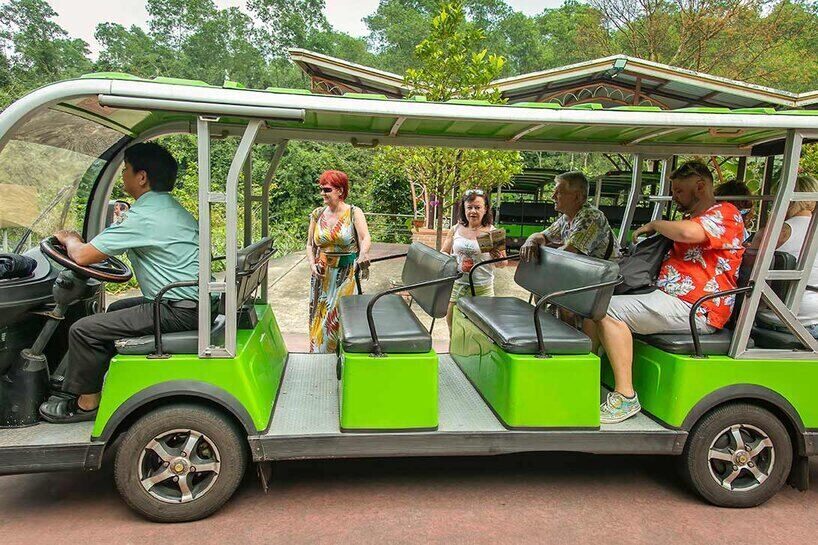
For those without a guide a well-marked path links all the different areas available for viewing and in front of each group of ‘buildings’ is a plaque that explains the significance of each group for the Cham people. There is a loop circuit so it makes sense to follow the loop (ie don’t return the same way you came) and maps of the paths and site locations are scattered around the site.
What to wear at My Son
As it is still seen as an important religious site, you should dress respectfully and modestly for your visit to My Son. This means wearing clothing that covers your knees and shoulders. And good walking shoes make sense.
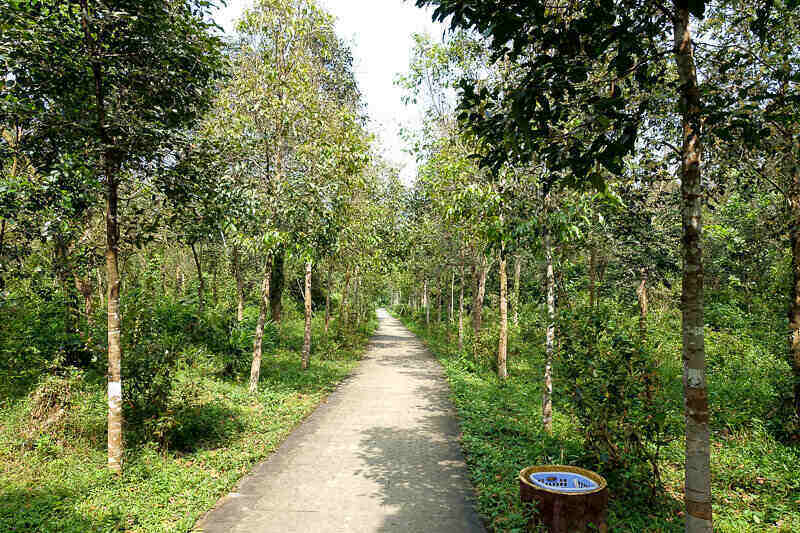
Best Time Of Day To Visit
When planning your My Son excursion, we recommend planning to arrive for the sunrise or a couple of hours before closing to have the best chance of avoiding crowds and peak mid-day heat. In short, early morning is the best time and mid-afternoon is the next best bet.
Aspara Dance, Folk Dance & Music
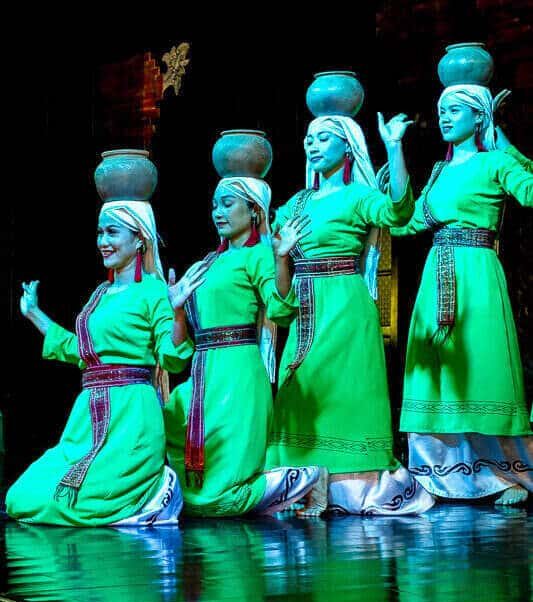
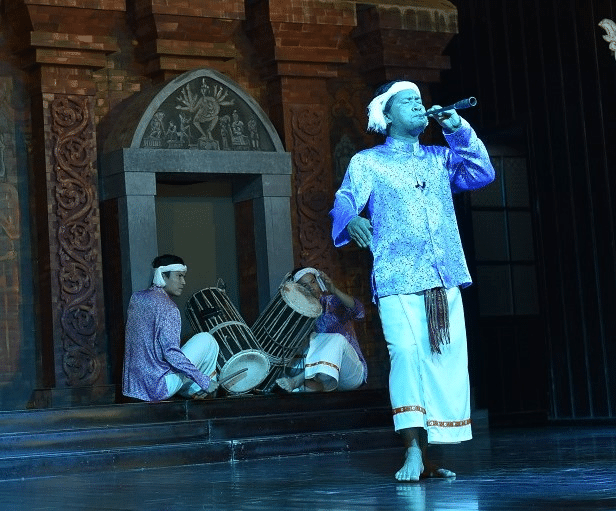
The Cham Show at My Son featuring Aspara Dance and Folk Music is staged 4 times a day: 9:15 am, 10:45 am, 2 pm and 3:30 pm. The show time is only 15 minutes but you do need to get to the ‘theater’ a little early to ensure a good seat for these popular performances.
The show begins with the ‘Dance with Water Pots’ where five beautifully attired women bring holy water in pots on their heads to a ritual prayer for rain, good harvests and prosperity.
In the second scene a performer in ancient traditional dress blows a long Champa flute or Saranai. Using circular breathing techniques like Australian indigenous didgery doo players and Mongolian limbe players, the performer can hold notes for minutes without a pause. The sound is more like a soprano saxophone than a flute (it was actually described by the English voice over as a trumpet!)
The show winds up with ‘Aspara Dance: the Dance of the Fairy Ladies’. In solemn ceremonies or festivals, Apsara dance, a favorite of Champa royalty, is performed. It is a spiritual appeal for peace and prosperity.
Tip: If you visit the major ruins near the theater just as the show is about to start or finish you will have an opportunity to take them in, in relative peace. At other times the crowds at this main temple complex and related buildings can be overwhelming and photography difficult as a result.
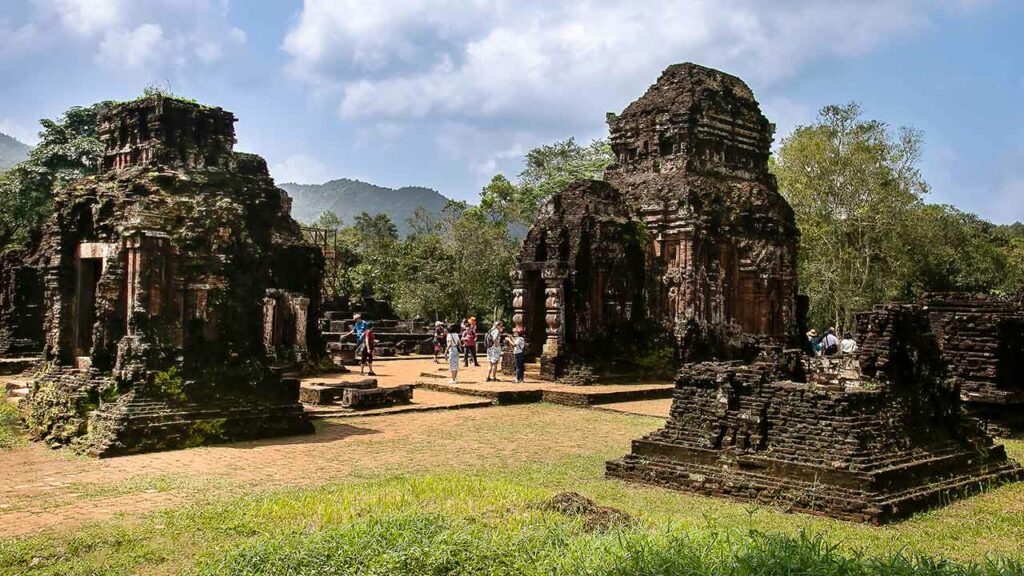
Points of Interest
Look out for bomb craters that pockmark the site from the American War.
The nearby mountain range was a safe shelter for the liberation fighters during the American War. While the US Air Force failed to hit the military base due to the difficult terrain, many temples either collapsed or were damaged by the assaults.
The bricks used in the temple construction were fired to a specific hardness and were probably laid using a natural tree resin. These combined technologies stood the test of time and are arguably superior to anything the modern day offers in terms of longevity.
Continuous restoration led by European and Indian archaeologists is ongoing.
Only recently was the site declared clear of unexploded ordnance.
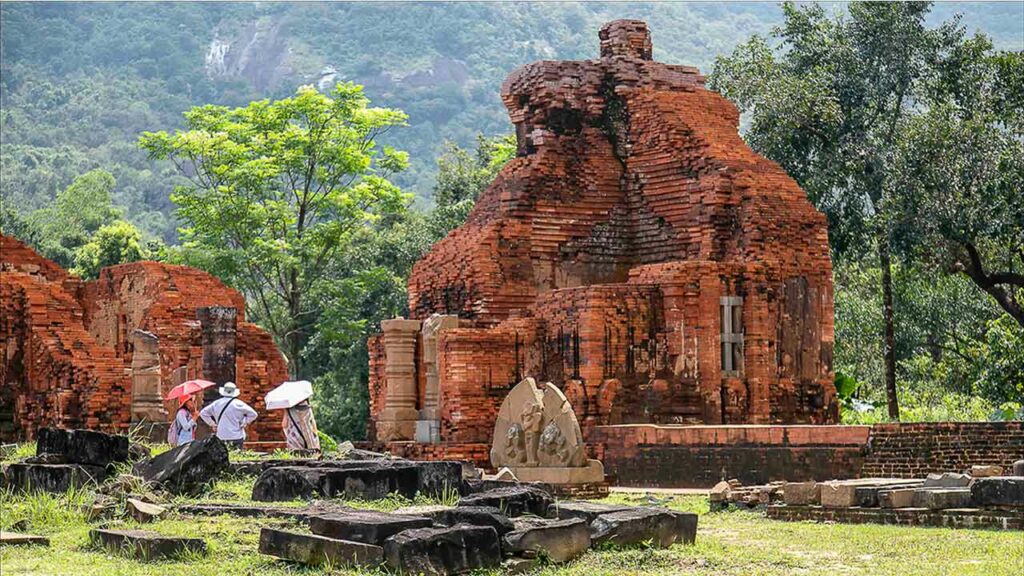
Frequently Asked Questions
If you are planning to book a tour then it’s a good idea to give reasonable notice. If you’re visiting under your own steam, there’s no need to book, tickets are on sale at the entrance. If booking a tour, check their cancellation policy before committing.
If you have the money, going by private car affords the greatest flexibility. And a private guide is just 100,000 VND. On the other hand, organized tours lay it all out for you on a platter. The best of the organized tours is a sunrise tour. Horses for courses.
3-4 hours is sufficient.
My Son Sanctuary reaches back over 1600 years and the My Son temple complex is considered one of the foremost Hindu temple complexes in Southeast Asia.
150,000 VND
Most people stay in hotels in Hoi An and the specific location there won’t matter much to your travel time. Another possibility much closer to the site is My Son Heritage Resort And Spa.
There are road-side cafes and a few places for tourists to eat and drink on the road between Hoi An and My Son. At the entrance and in the complex itself there are reasonably priced restaurants and cafes serving traditional Vietnamese fare.
There are no other attractions nearby, most are closer to Hoi An. The closest are: (14.16 mi) Thanh Ha Terracotta Park; (15.32 mi) Kim Bong Carpentry Village; (14.10 mi) Thanh Ha Pottery Village